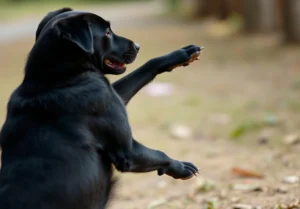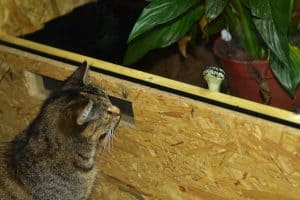Cats exhibit a unique fearlessness in the face of snakes that may leave many people puzzled. But why are cats not afraid of snakes? Let’s delve into the fascinating relationship between these two creatures.
Instinctual Behavior
Cats aren’t afraid of snakes because their instincts kick in when faced with a slithery foe. Picture this: your cat’s ancestors prowling the wild, encountering snakes left and right. Over time, cats learned that confronting these sneaky serpents head-on was the way to go. It’s in their DNA to not back down from a scaly challenge.
You see, felines have a keen eye for movement, detecting even the slightest twitch in a snake’s approach. This innate ability helps them stay one step ahead, ready to pounce with lightning speed. So, when Mittens locks eyes with a snake, it’s not fear you see in those mesmerizing feline orbs – it’s pure predatory focus.
And let’s not forget that classic feline grace and agility. Cats are nimble creatures, able to twist and turn with finesse, making them a formidable match for a slithering adversary. So, next time your cat faces off against a snake, remember, it’s all in a day’s work for your fearless feline friend.
Evolutionary Adaptations
When it comes to confronting snakes, cats have a few tricks up their furry sleeves thanks to evolutionary adaptations. Over millennia, cats have honed their skills to effectively deal with these scaly foes.
One key adaptation is their flexible spine, allowing them to arch and hiss in a show of intimidation. This display may seem like a dance of death, but it’s a calculated move to keep the snake at bay. Additionally, cats have retractable claws that come in handy for quick strikes and nimble maneuvers.
Moreover, cats have developed a keen sense of hearing and smell, allowing them to detect a snake’s presence even before a visual encounter. This heightened awareness gives them a distinct advantage in the wild, where every second counts in a potential snake showdown.
So, the next time your whiskered companion stares down a snake with unwavering determination, know that it’s not just bravery at play – it’s a culmination of millennia of evolution shaping your cat into the confident predator it is today.
Hunting Techniques
Cats are skilled hunters, utilizing a combination of instinct and strategy to catch snakes. Their agility, speed, and sharp senses contribute to their fearlessness in the face of these reptiles. Cats often rely on the element of surprise, stalking their prey silently before pouncing with lightning-quick reflexes.
In addition to their physical prowess, cats have a keen sense of observation. They carefully study their surroundings and prey, assessing the best approach to ensure a successful catch. This attentiveness allows them to identify potential threats, including snakes, and devise a plan to neutralize them effectively.
Defensive Strategies
When it comes to encountering snakes, cats have developed various defensive strategies to protect themselves. One key tactic is their ability to read snake behavior and respond accordingly. Cats are quick to pick up on subtle movements and sounds that signal danger, allowing them to react swiftly to avoid harm.
Moreover, cats leverage their agility and flexibility to evade snake attacks. They can swiftly dart out of reach, using their nimbleness to outmaneuver their serpentine foes. Cats also have sharp claws and teeth that they can deploy in self-defense if necessary, providing an extra layer of protection against potential threats.
Additional Unique Insight:
- Cats possess a unique method of pouncing on snakes, aiming for the head to incapacitate them swiftly.
- Cats’ heightened senses, such as exceptional night vision and acute hearing, give them an edge in detecting snakes before a confrontation occurs.
Communication Signals
Cats use a variety of communication signals to warn each other about the presence of snakes in their territory. They may hiss, growl, or yowl to alert other cats to the danger. Additionally, cats may puff up their fur to appear larger and more intimidating when they sense a snake nearby. This communication helps to keep all cats in the area aware of potential threats and allows them to coordinate their responses.
Behavioral Responses
When faced with a snake, cats exhibit quick reflexes and strategic maneuvers to protect themselves. They often use their agility to leap out of the snake’s striking range or to pounce on the snake from a safe distance. Cats may also bat at the snake with their paws or swat at it with their claws to ward off the threat. In some cases, cats may even mimic the snake’s movements, such as slithering low to the ground, as a form of defense.
- Cats rely on their keen sense of sight and hearing to detect snakes before they get too close.
- Cats may also use their sense of smell to identify the presence of snakes in their environment.
- Some cats have been known to vocalize in a specific way when they encounter a snake, signaling to other cats in the area that there is a threat present.
By understanding these communication signals and behavioral responses, we can appreciate why cats are not afraid of snakes and how they effectively protect themselves in the face of danger.
Domestic Cat Behavior
Domestic cats, unlike their wild counterparts, have been raised in human environments since kittenhood. This early exposure to various stimuli, including snakes, may lead to a decreased fear response towards them. The lack of predatory pressure in a domestic setting also plays a role in shaping a cat’s behavior towards snakes. This unique environment can result in cats being more curious rather than fearful when encountering a snake, as they may not perceive them as a direct threat.
Curiosity vs. Fear
When it comes to cats and snakes, it’s all about the balance between curiosity and caution. Cats are naturally curious creatures, always investigating their surroundings with a sense of wonder. This innate curiosity can often override their instinctual fear response, especially when faced with a novel and intriguing creature like a snake. While some cats may exhibit a fearless attitude towards snakes, it’s important to remember that this behavior is not universal. Some cats may still exhibit caution or even fear towards snakes, depending on their individual personalities and past experiences.
Tips for Encountering Cats and Snakes:
- Observe their body language: Cats may exhibit signs of curiosity or caution when encountering a snake. Watch for dilated pupils, raised fur, or a tense body posture.
- Provide a safe environment: If you have a pet cat and live in an area with snakes, take precautions to keep your cat and the snakes separated to avoid any potential conflicts.
- Consult a veterinarian: If you notice any unusual behavior in your cat after encountering a snake, such as excessive fear or aggression, seek advice from a veterinarian to ensure your cat’s well-being.
Remember, every cat is unique, and their behavior towards snakes can vary widely. By understanding the balance between curiosity and caution in cats, you can better navigate their interactions with snakes in a safe and responsible manner.
Fun Facts
Cats have a natural instinct to hunt and catch prey, which includes snakes. Unlike humans who may fear these slithery creatures, cats see them as potential playthings or meals. This fearlessness can be traced back to their wild ancestors, who relied on hunting for survival.
Did you know that cats have a unique way of dealing with snakes? One fascinating fact is that they can detect the scent of a snake using their keen sense of smell. This allows them to be aware of the snake’s presence long before they see it, giving them the upper hand in any encounter.
Another interesting tidbit is that cats have specialized reflexes that help them defend against snake attacks. They are quick on their feet and can easily avoid a snake’s striking range. Their agility and speed make them formidable opponents for even the most venomous snakes.
In addition to their physical abilities, cats are also known for their intelligence. They can assess a situation quickly and decide on the best course of action when faced with a snake. This combination of skill, instinct, and intelligence makes cats fearless when confronting snakes.
So, next time you see your feline friend fearlessly facing off against a snake, remember that their natural abilities and instincts play a crucial role in their fearlessness. Cats are truly fascinating creatures with a unique relationship with snakes.
Alex, a passionate animal lover, has experience in training and understanding animal behavior. As a proud pet parent to two dogs and three cats, he founded AnimalReport.net to share insights from animal experts and expand his knowledge of the animal kingdom.




